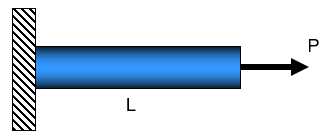|
Out of clutter, find simplicity.
From discord, find harmony.
In the middle of difficulty, lies opportunity -
Albert Einstein, The Three Rules of Work
Part 1: Consider the linear-elastic
prismatic bar fixed on the left-hand-side and loaded by axial forces P at
the right-hand-side, as shown in figure below (assume all measurements are
"exact"). In all cases, report answers to three significant figures.

- If the allowable stress at failure for the material is
15,000 psi and the applied load on the bar is P = 5,000 lb., what is the
minimum area required to prevent failure?

- If the bar fails at strains greater than 0.03 and the
original length of the bar is L = 30 in., what is the maximum
allowable deformation before failure?

- If the material in the bar is considered linear-elastic, the tensile
stress is 15,000 psi, and the tensile strain is 0.01, what is the material's
modulus of elasticity?

- If the original length of the bar is L =
10 ft. and it deforms 0.12 in., what is the stress in the material if the modulus of
elasticity of 29,000 ksi?

- Determine the cross-sectional area of a steel cable
required to support a 10,000 lb. tensile force over 100 ft. while not exceeding the
allowable tensile stress of 60,000 psi or a maximum elongation of 0.1 ft. Assume the
modulus of elasticity of steel is E = 29,000,000 psi.

The controlling value for the area is that computed in Case 2 - the
minimum area to prevent failure in stress or strain is A = 0.344 in2.
This website was originally
developed by
Charles Camp for
CIVL
1101.
This site is
Maintained by the
Department of Civil Engineering
at the University of Memphis.
Your comments and questions are welcomed.
|



